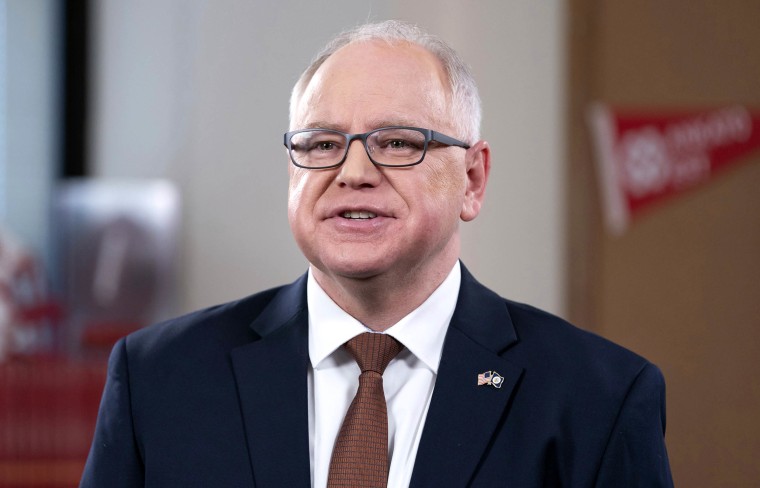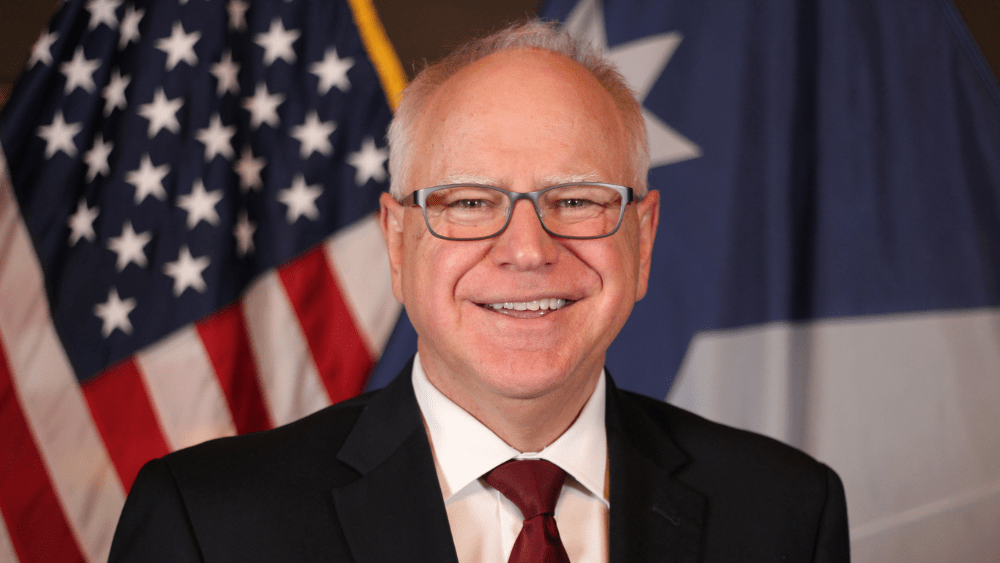Tim Walz: Minnesota Tim Walz

Tim Walz is the 41st and current governor of Minnesota. A former teacher and U.S. Representative, Walz has a long history of public service in the state.
Early Life and Education
Born in 1964 in Mankato, Minnesota, Walz grew up in a working-class family. He attended Mankato West High School and later earned a bachelor’s degree in history from Mankato State University. After graduation, he worked as a history teacher and football coach at various high schools in Minnesota.
Political Career
Walz’s political career began in 2006 when he was elected to the Minnesota House of Representatives. He served in the House for six years, representing a district in southwestern Minnesota. During his time in the House, he was known for his work on education and veterans’ issues.
In 2012, Walz was elected to the U.S. House of Representatives, representing Minnesota’s 1st congressional district. He served in the House for six years, focusing on issues such as agriculture, education, and veterans’ affairs. He was a vocal critic of the Trump administration’s policies.
Governor of Minnesota
In 2018, Walz was elected governor of Minnesota, defeating Republican Jeff Johnson. He took office in January 2019.
Key Accomplishments and Initiatives
Walz has focused on a number of key issues during his time as governor, including:
- Education: Walz has prioritized education funding and has worked to expand access to early childhood education. He has also supported initiatives to improve teacher training and classroom technology.
- Healthcare: Walz has been a strong advocate for expanding access to affordable healthcare. He has supported the Affordable Care Act and has worked to address the opioid crisis in Minnesota.
- Economic Development: Walz has worked to promote economic growth in Minnesota, focusing on job creation and investment in infrastructure. He has also supported efforts to expand access to affordable housing.
Political Stances and Policies
Walz is generally considered a progressive Democrat. He has consistently supported policies that promote social justice, environmental protection, and economic equality.
- Gun Control: Walz supports stricter gun control measures, including universal background checks and a ban on assault weapons.
- Climate Change: Walz believes that climate change is a serious threat and has supported policies to reduce greenhouse gas emissions. He has also advocated for investments in renewable energy sources.
- Social Justice: Walz is a strong advocate for racial justice and equality. He has supported policies to address systemic racism and discrimination.
Governing Style
Walz is known for his collaborative approach to governing. He has worked to build consensus among lawmakers and has been willing to compromise on issues. He is also known for his commitment to transparency and accountability.
Comparison with Predecessors
Walz’s governing style contrasts with that of his predecessor, Republican Mark Dayton. Dayton was known for his more independent approach to governing, often working to build coalitions across party lines. Walz, on the other hand, has been more focused on working with his fellow Democrats to advance his agenda.
Minnesota Politics and Governance

Minnesota’s political landscape is characterized by a long tradition of progressive values and a strong commitment to social justice. The state is known for its robust social safety net, its dedication to environmental protection, and its embrace of diverse communities.
Major Political Parties and Platforms
Minnesota’s political scene is dominated by the Democratic-Farmer-Labor Party (DFL) and the Republican Party. Both parties have distinct platforms that reflect their differing ideologies and priorities.
- The DFL, often referred to as the Democratic Party, generally advocates for social programs, environmental protection, and a strong public sector. They typically support policies that promote economic equality, affordable healthcare, and access to education.
- The Republican Party, on the other hand, tends to favor lower taxes, less government regulation, and a strong national defense. They often support policies that promote free markets, individual liberty, and traditional values.
Structure and Powers of the Minnesota Government
Minnesota’s government operates under a system of separation of powers, with distinct branches responsible for different functions.
- The Executive Branch is headed by the Governor, who is responsible for enforcing state laws, appointing state officials, and proposing legislation. The Governor also holds significant power in shaping the state budget.
- The Legislative Branch consists of the Minnesota House of Representatives and the Minnesota Senate. The legislature is responsible for enacting state laws, approving the budget, and overseeing the state government.
- The Judicial Branch is responsible for interpreting the law and ensuring that laws are applied fairly. The Minnesota Supreme Court is the highest court in the state.
Role of Public Opinion and Media
Public opinion plays a significant role in shaping Minnesota’s political discourse and influencing public policy. Polls and surveys provide valuable insights into public sentiment on various issues, which can influence the decisions of elected officials. The media, through news reporting, commentary, and analysis, also shapes public opinion and holds elected officials accountable.
“Public opinion is the voice of the people, and it is essential for a healthy democracy.”
Challenges and Opportunities Facing Minnesota
Minnesota faces a number of challenges, including:
- Economic inequality: The gap between the rich and poor in Minnesota is growing, with some communities facing higher poverty rates and limited access to opportunities.
- Climate change: Minnesota is experiencing the effects of climate change, including more extreme weather events, rising temperatures, and changes in precipitation patterns.
- Education disparities: There are significant disparities in educational outcomes across different demographic groups in Minnesota, with students of color and students from low-income families often facing greater challenges.
However, Minnesota also has significant opportunities for growth and progress, such as:
- A strong economy: Minnesota has a diverse and resilient economy, with strengths in sectors like healthcare, technology, and manufacturing.
- A highly skilled workforce: Minnesota has a well-educated and skilled workforce, which is an asset for attracting new businesses and investment.
- A commitment to innovation: Minnesota is a hub for innovation, with a thriving startup ecosystem and a strong culture of entrepreneurship.
Hypothetical Scenario: Debating and Implementing a Policy Initiative
Imagine a proposal to increase funding for early childhood education in Minnesota. This policy initiative would be debated and implemented through a complex process involving various stakeholders.
- The Governor might propose the initiative as part of their budget proposal, outlining the need for early childhood education and the potential benefits for children and families.
- The Legislature would then debate the proposal, with different perspectives emerging from both the DFL and Republican parties. Some lawmakers might support the initiative, while others might raise concerns about its cost or its impact on other priorities.
- Public opinion would also play a role, with advocacy groups and parents voicing their support or opposition to the initiative. The media would likely cover the debate, providing information and analysis to the public.
- If the legislature approves the initiative, the Governor would sign it into law. The implementation of the initiative would then be overseen by state agencies, with funding allocated to local school districts and early childhood programs.
Minnesota’s Socioeconomic Landscape

Minnesota boasts a diverse and dynamic socioeconomic landscape, characterized by a strong economy, a high standard of living, and a commitment to social equity. However, the state also faces challenges related to income inequality, racial disparities, and access to quality education and healthcare.
Minnesota’s Economy
Minnesota’s economy is characterized by its diverse industrial base, which includes sectors such as healthcare, manufacturing, agriculture, and technology. The state has a strong track record of economic growth, with a relatively low unemployment rate and a high per capita income. Major industries contributing to Minnesota’s economic prosperity include:
- Healthcare: The healthcare industry is a significant contributor to Minnesota’s economy, employing a large workforce and generating substantial revenue. The state is home to world-renowned medical institutions such as the Mayo Clinic and the University of Minnesota Medical Center.
- Manufacturing: Manufacturing remains a vital part of Minnesota’s economy, with a focus on industries such as food processing, medical devices, and transportation equipment. The state has a long history of manufacturing excellence, with companies like General Mills, Medtronic, and 3M headquartered in Minnesota.
- Agriculture: Agriculture is a cornerstone of Minnesota’s economy, with a strong tradition of farming and food production. The state is a leading producer of corn, soybeans, dairy products, and other agricultural commodities.
- Technology: The technology sector is rapidly growing in Minnesota, driven by the state’s strong educational institutions, research capabilities, and a skilled workforce. Companies like Target, Best Buy, and Cargill are investing heavily in technology and innovation.
Demographics and Diversity
Minnesota has a population of approximately 5.7 million people, with a diverse mix of racial and ethnic groups. The state’s population is predominantly white, but there are significant populations of African Americans, Asian Americans, Hispanic Americans, and Native Americans.
- Population Distribution: Minnesota’s population is concentrated in the Twin Cities metropolitan area, which includes Minneapolis and St. Paul. The state also has a significant rural population, particularly in the northern and western regions.
- Racial and Ethnic Diversity: Minnesota’s demographics are becoming increasingly diverse, with a growing number of immigrants and people of color. The state has a long history of welcoming immigrants, and it continues to be a destination for people seeking opportunity and a better life.
- Socioeconomic Disparities: While Minnesota is known for its high quality of life, there are significant socioeconomic disparities between different racial and ethnic groups. For example, African Americans and Native Americans in Minnesota experience higher rates of poverty, unemployment, and health disparities compared to the overall population.
Challenges and Opportunities in Education, Healthcare, and Infrastructure, Minnesota tim walz
Minnesota faces a number of challenges related to its education system, healthcare system, and infrastructure.
- Education: Minnesota has a strong public education system, but it faces challenges related to funding, teacher shortages, and achievement gaps. The state is working to improve its education system by investing in early childhood education, supporting teachers, and promoting equity in education.
- Healthcare: Minnesota has a high-quality healthcare system, but it faces challenges related to access, affordability, and disparities. The state is working to expand access to healthcare, improve affordability, and address health disparities.
- Infrastructure: Minnesota’s infrastructure is aging and in need of investment. The state faces challenges related to transportation, energy, and water resources. Minnesota is investing in infrastructure projects to improve transportation, energy efficiency, and water management.
Socioeconomic Performance Compared to Other States
Minnesota consistently ranks high in national rankings for quality of life, education, and healthcare. However, the state also faces challenges related to income inequality, racial disparities, and access to affordable housing.
- Midwest Comparison: Compared to other states in the Midwest, Minnesota generally performs well in terms of economic growth, education, and healthcare. However, the state faces challenges related to affordability and income inequality, similar to other Midwestern states.
- National Comparison: Compared to other states in the United States, Minnesota ranks high in terms of quality of life, education, and healthcare. However, the state also faces challenges related to income inequality and racial disparities, which are national issues.
Key Statistics and Indicators
| Indicator | Value |
|---|---|
| Population | 5,706,494 (2023 estimate) |
| Median Household Income | $80,409 (2022 estimate) |
| Unemployment Rate | 2.2% (July 2023) |
| High School Graduation Rate | 87.5% (2021-2022) |
| Life Expectancy | 79.5 years (2020) |
Minnesota tim walz – Minnesota Governor Tim Walz, known for his unwavering commitment to community and progress, embodies the spirit of athletic excellence. This spirit is reflected in the thrilling rise of sport climbing, a discipline that pushes physical and mental boundaries. Witness the breathtaking feats of these climbers in the sport climbing combined olympics video , and you’ll see a testament to the power of dedication and perseverance, much like the spirit that drives Governor Walz’s leadership in Minnesota.
Minnesota Governor Tim Walz has navigated the challenges of the pandemic with a focus on public health and safety, a commitment that resonates with many across the country. While his leadership has faced criticism, it’s important to remember that navigating these unprecedented times requires a blend of decisiveness and compassion.
This is exemplified by the recent nassau county ban masks , a decision that has sparked debate nationwide, underscoring the complexities of public health policy. Ultimately, Governor Walz’s leadership, like that of other elected officials, will be judged by the long-term impact of his decisions on the people of Minnesota.